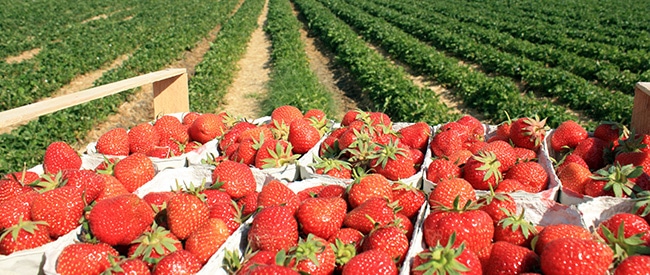Risk Management on the Farm: Fruit and Berry

Risk management on the farm helps protect everyone. This five-part series introduces various safety challenges on different types of farms, check out Part 1: Poultry; Part 2: Dairy; Part 3: Ranch; and Part 4: Grain.
When was the last time you reviewed your fruit and berry risk management plans? From the first flower in spring to the final harvest (for both short and long growing seasons) adding safety precautions protects you and your employees. Read on for tips and best practices for fruit and berry farms like cranberries, apples, blueberries and more.
Machinery
To grow fruit and berries, farmers make use of an extensive suite of machinery like irrigation systems, sprayers, tractors, harvesting machines, spreaders, and weeders. Ensure you never miss a beat with these risk management tips:
- Always give a wide berth when walking around operating machinery
- Give staff regular training for how to operate farm machinery
- Follow all manufacturer’s directions for maintaining machinery
- Keep a record of all regular maintenance completed on machinery such as oil changes, repairs to tires or belt changes
- Store machinery under cover to protect it from the elements, where possible
- Add a fire extinguisher to each machine
- Wear the right attire for the job i.e. tie back long hair, tie shoelaces, tuck in shirt
- Be alert when operating machinery, this means paying attention and avoiding consumption of any substance that may impair you
- Wait for machinery to completely stop before touching it
- Keep children and pets away from machinery
- Use the right size machinery for the job at hand
Farm Employees
Many fruits and berries are still picked by hand though some machinery has advanced enough to harvest specific crops. Ensure your farm’s procedures and safety practices are modernized in order to protect your team and improve pick rates.
- Provide training about dangers on the farm and how to be safe
- If using ladders, how to place a ladder safely, never stand on the top two rungs of a ladder
- Stay away from operating machinery
- Provide employees with easy to access sanitation services i.e. hand washing and restrooms
- Ensure employees have access to fresh drinking water
- Designate first aid locations and provide a fully stocked first aid kit
- Train employees on how to safely use any machinery that is part of their job
- Lock up pesticides and fumigants, ensure only fully trained employees are tasked to apply those substances to fields
Preventing Contamination
Many fruits and berries are consumed raw so taking steps to prevent contamination is important both for public health and protecting your harvest.
- Avoid planting fields in know flood areas
- Store manure away from the growing and handling areas
- Ensure manure storage measures prevent any runoff and wind drift
- Record all soil adjustments including application dates, what was applied, and method of composting or treatment
- Inspect water sources including wells before each growing season to identify any potential sources of contamination
- Clean and sanitize bins, tools, and wagon beds before harvesting
Processing and Storage
After harvest, thousands of kilograms of produce must be processed and packed for sale. Processing and storage are critical steps to preserving the quality of the produce and ensuring maximum profit from a season worth of work.
- Keep up with pest management practices to discourage rodents and other critters from farm buildings storing produce
- Remove as much debris from farm produce in the fields
- Keep food safety top of mind
- Reuse packaging with caution, ensure it is durable and able to be cleaned and sanitized before each use
Farm Diversification
Many farmers with fruit and berry operations choose to diversify with u-pick, seasonal events (like festivals), and grocery items. Adding activities like these—where you invite the public to your farm or produce a manufactured food item for the public to purchase—change fruit and berry risk management needs.
- Ensure current local government best practices are in place when manufacturing food for human consumption
- Provide adequate on-site parking and directional signage for visitors to find the check-in point, fields, and restrooms
- Lock up farm machinery and other private areas on the farm to discourage curious visitors
Chat with your insurance broker about any questions you may have regarding your farm insurance policy and how it may protect you in the event of a loss.

